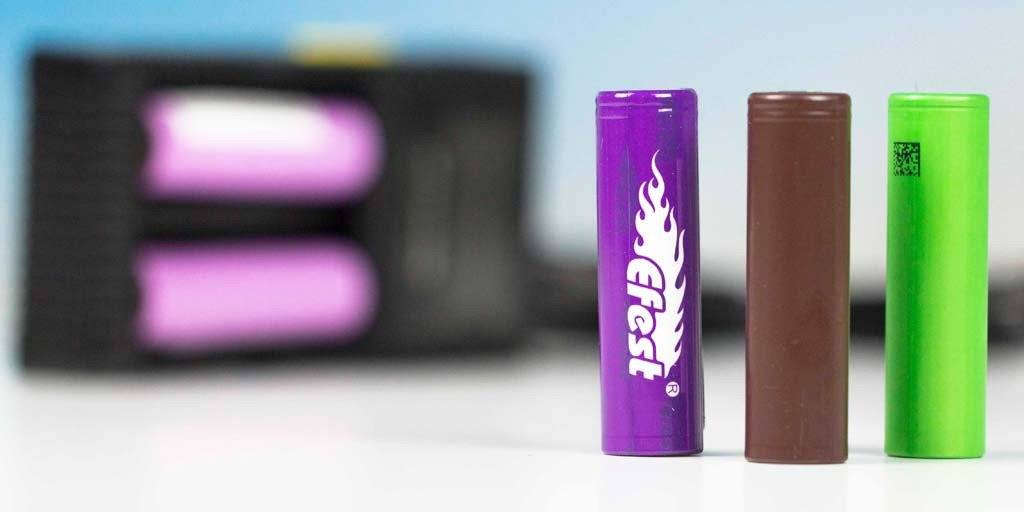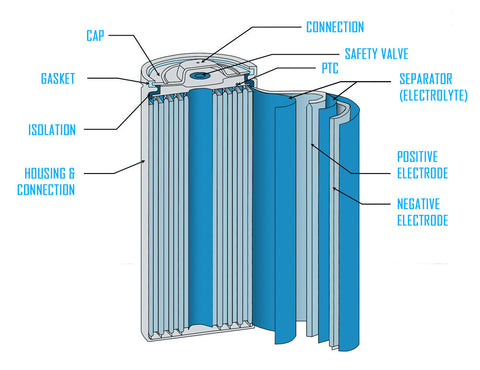
Tutorial: Vape Battery Safety and Tips
You might think that the electronic technology involved in vaping is similar to the electronics involved in a smartphone or a flashlight, and for the most part, you would be right. The basic principles are the same. But then you notice that the batteries we’re using are a little more stout than the AA’s in your TV remote. Then you might see a news report where someone sets his backpack on fire with a mod, and you wonder, how? How does this happen with vaping but not with your MP3 player?
Here’s the thing: vaping requires power, and we don’t mean power like a portable Bluetooth speaker uses. We mean massive current. Vaping uses power like almost no other consumer electronic device, at a tremendous rate, meaning that there are serious risks. Newer devices have loads of safety features, but they can’t eliminate every possible way to abuse your gear. And that’s why we need to talk about safety.
 As it has been for many years, the vaper’s battery of choice is the 18650 cell. That’s a size measurement, 18mm diameter and 65mm long. The 18650 comes in a lot of different varieties with a lot of different performance ratings. And vaping requires the best. When you factor in weight, longevity, price, and the ability to handle huge amperage, the 18650 owns every other type of battery, which is why you see them bundled into almost every high-powered electrical device you can buy, from computers to power tools to the Tesla automobile. We need to know how to use all this power, and how to make sure you aren’t pushing it too far.
As it has been for many years, the vaper’s battery of choice is the 18650 cell. That’s a size measurement, 18mm diameter and 65mm long. The 18650 comes in a lot of different varieties with a lot of different performance ratings. And vaping requires the best. When you factor in weight, longevity, price, and the ability to handle huge amperage, the 18650 owns every other type of battery, which is why you see them bundled into almost every high-powered electrical device you can buy, from computers to power tools to the Tesla automobile. We need to know how to use all this power, and how to make sure you aren’t pushing it too far.
If you have been vaping for more than a couple of years, you probably know this. Back in the bad old days, we had to use mechanical mods to get decent vapor output, and a mechanical is basically just a tube with a switch. The only safety was usually just a button lock, and some didn’t even have that.
Pretend you’re one of those old school vapers using a mechanical mod, and you need to figure out whether your setup is safe. Ultimately, this means you need to know that electricity won’t be drawn out of it too fast, like water being drained from a tank. If you drill a hole in a water tank and the water starts to spray out of it at high pressure, then the hole can widen and the tank could rupture. You want to avoid the electrical equivalent, which happens when a battery gets pushed too hard, causing too much heat to build up, rupturing the case and venting the battery.
So, how do you figure whether your build is going to draw too much amperage from your battery? Simple: it’s called math. You plug some numbers into an equation and calculate. But don’t worry! It’s not a tough problem. The equation only has three variables, so you just need to deal with two numbers in order to calculate the third. After you get used to it, the process is almost as easy as calculating a tip at a restaurant.
The equation goes like this: A=V/R. It means “amperage equals voltage divided by resistance”. It’s called Ohm’s Law.
An 18650 battery has two amperage limits. The first limit is the continuous rating, the amperage draw the battery can take at a constant rate until it runs out of power. The second limit is the pulse rating, which is the amperage draw it can take for a brief burst. You might be tempted to use the second rating, but this is how you push the envelope and get hurt and make the news and get the FDA involved. Use the continuous rating.
A fully charged battery is like a tank filled with water, meaning there is full pressure inside. Electrical pressure is called “voltage”. Most fully charged 18650 batteries have a voltage of 4.2, so use this number for safety purposes regardless of whether your batteries are fully charged at the moment or not.
Then all you need is the resistance, which you can figure out by using an ohmmeter. Resistance is like the diameter of the pipe the water is running through. Coils that use thicker wire will have a lower resistance, for the same reason water pipes with bigger diameters can let more water flow. And because of some interesting magnetic field properties, coils that use more wraps will have a higher resistance. We will assume you use Kanthal A1 instead of temp control wire, as Kanthal has a simple, constant resistance. Temp control requires advanced circuitry and can’t be done on a mechanical.
Say you wrap your own coils on an RDA, and you run a dual coil build made up of 24 gauge wire wrapped 7 times around a 3mm bit. You will probably have a resistance around 0.2 ohms, low sub-ohm territory.
Now, do the math. 4.2 divided by .2 gives you 21. So use a battery with a continuous rating of 21 amps.

It’s that simple. If you want it to be even simpler and you aren’t building sub-ohm, try using our Variable Voltage and Vaping Power Chart or Vape Safety Calculator
When you go looking for high-amp 18650’s, you won’t have as many choices as you might think. The Samsung 25R and the LG HE2 and HE4 continue to dominate the market, although for multi battery setups, the LG HG2 brownies are rising fast, mostly due to their 3000mAh endurance. The Sony VTC4 and VTC5 used to be the most sought after due to their extremely high continuous power rating of at least 30 amps, and still work very well, particularly in mechanical mods. These batteries come highly recommended. Batteries from Panasonic are good quality but none of them have a higher continuous rating than 10 amps.21 amps is fairly standard for vapers and that’s a lot of power for any portable electronic device, so it’s very important to get a good battery. Even if your mod uses the latest safety features, they are designed with high-amp batteries in mind and they can still draw too much current from a battery that’s below specification.
Almost everything else we see on the market, especially batteries specifically marketed for vapers – Imren, Efest, SubOhmCell, Vamped – is a relabeled version of these three brands, and we strongly suspect that some of them are factory seconds that tested below spec. Those are still far better than using a battery with a name like Trustfire or Ultrafire, either of which will probably start a fire and you should keep it away from your vape.
No matter which high-amp battery you choose, you need to keep an eye on the condition of the wrapping. An 18650 with no wrap is dangerous, because the entire outside surface acts like a negative contact and accidental firing becomes way too easy. Don’t use batteries with torn up wrappers! Get them rewrapped or buy new ones. You can expect to buy new ones after about 8 months or 200 charge cycles anyway, as they wear out and you will notice they don’t hang on like they used to.
To extend their life, use a quality charger. Efest and Nitecore make some of the best on the market. They have circuitry to make sure your batteries don’t get overcharged or undercharged, and they charge faster than the built in charge circuitry most mods use. Avoid the cheap single bay chargers which plug directly into the wall outlet instead of having a cord. They tend to only charge your batteries to about 90%, which will cut their lifespan.
The last point you need to keep in mind is that nearly every vaping device has some sort of lock on it to keep you from firing it accidentally. If you’re going to carry it in your pocket, use the lock! Even with a ten second cut-off, carrying an unlocked mod in your pocket can result in firing it on and off as you walk or move around, getting your tank or RDA very hot, melting plastic and rubber parts, and maybe even combusting your pants. Trust us, that isn’t as much fun as it sounds.
That’s most of what you need to know, but if you ever have any doubts that what you are using is safe, ask the people at a reputable vape shop. Not only can this keep you out of the burn ward, it can keep critics of vaping from finding ammunition they use to make vaping out to be a public menace. Media outlets tend to run with any story that makes vaping out to be a hazardous choice, so any honest accident will probably end up adding fuel to the worst stereotypes we are in the middle of fighting right now. One mistake, and the good work of hundreds of activists and researchers trying to keep this industry alive can end up in the dumpster.
Vape safe and enjoy!


Leave a comment